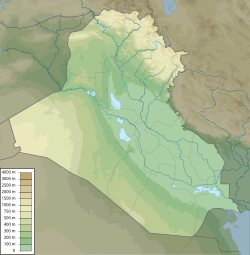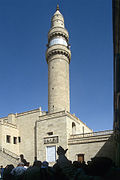Top Qs
Timeline
Chat
Perspective
Al-Nabi Yunus Mosque
Destroyed mosque in Mosul, Iraq From Wikipedia, the free encyclopedia
Remove ads
The Al-Nabi Yunus Mosque (Arabic: جَامِع ٱلنَّبِي يُوْنُس, romanized: Jāmiʿ An-Nabī Yūnus), also known as the Mosque of the Prophet Jonah, the Mosque of the Prophet Yunus, and the Shrine of Nabi Yunis,[a] was a historic Sunni congregational mosque and shrine, partially[citation needed] destroyed in 2014, that was located in Mosul, in the Nineveh Governorate of Iraq. It contained a tomb believed to be that of the Biblical prophet Jonah, known as Yunus by Muslims.[b]
Remove ads
History
Summarize
Perspective
The alleged grave of the Prophet Yunus was discovered by Jalal al-Din Ibrahim al-Khatni during his reconstruction of the site as a congregational mosque in 1365 CE.[3] However, the mosque was also built over a demolished Assyrian Christian church that marked Jonah's grave.[4][5]
In 1924, the minaret was added to the mosque building by a Turkish architect. During Saddam Hussein's rule, the mosque was renovated and expanded.[1]
The mosque had one minaret and a conical ribbed dome. The floors of the mosque were built out of Alabaster and the prayer rooms had arched entrances that were inscribed with Quranic verses.[5]
The alleged tomb of Jonah[1] was located at a corner of the mosque. The sarcophagus believed to be that of Jonah had a wooden zarih built around it.
In addition to Jonah's tomb, a modern shrine which contains the tomb of Shaykh Rashid Lolan is present next to the mosque.[6] This shrine dates from the 1960s.[6]
2014 destruction
On 24 July 2014, the building was blown up by the Islamic State of Iraq and the Levant,[7][8] damaging several nearby houses. ISIL stated that "the mosque had become a place for apostasy, not prayer."[7]
Archeological discovery
In March 2017, after ISIL was driven out, a system of tunnels, approximately one-kilometre-long (zero-point-six-two-mile) were found under the mosque. Although all moveable items had been removed, there were still Assyrian reliefs, structures and carvings along the walls.[1]
Remove ads
Gallery
- Mosque ruins in 2017
- The mosque and shrine in 2011, prior to its 2014 demolition by ISIL
- The mosque and shrine in 1999
- Steps leading to the mosque in 1999
- The mosque and shrine in 1932
See also
Notes
References
External links
Wikiwand - on
Seamless Wikipedia browsing. On steroids.
Remove ads








